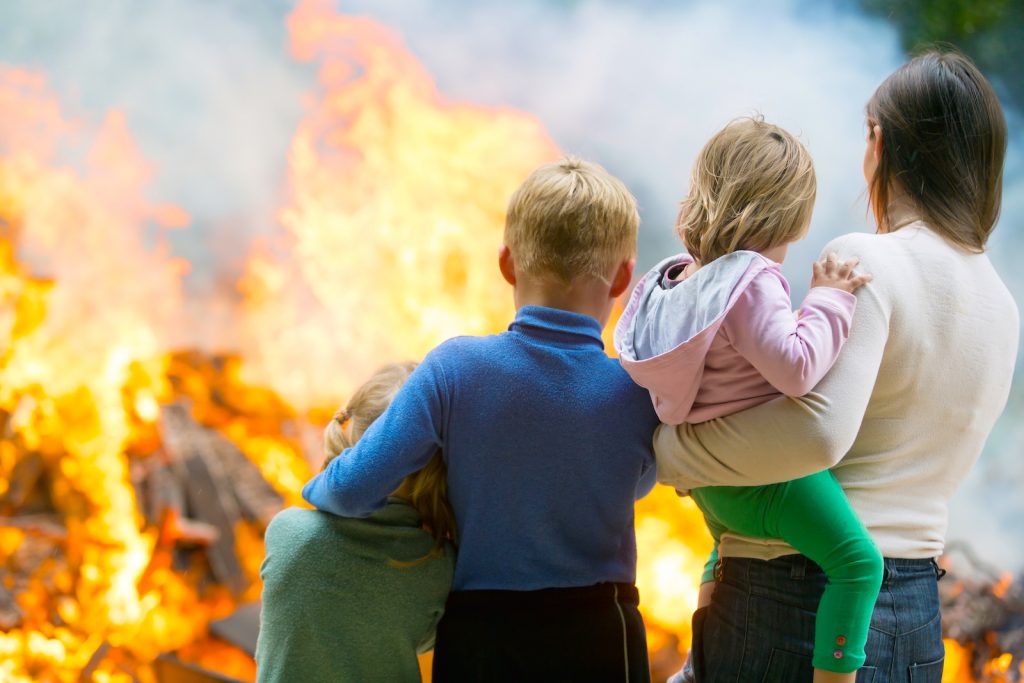Creating an effective home emergency plan will help you feel confident that your family will be able to get through any kind of crisis together. Whether it is a natural disaster or a global health crisis, many of the same steps apply. According to the Red Cross, there are three simple steps that encompass implementing an effective home emergency plan. Doing so protects your family in as many situations as possible and increases your chances of being able to stay together safely.
The first step of creating a home emergency action plan is to come together as a family to outline the types of disasters that are most likely to affect your family. Then, identify how you can prepare to meet the challenges of each of these emergencies.
Next, you’ll want to identify what each member of your family is responsible for handling in the case of each emergency. You’ll also want to designate a lead communicator.
The final step is to practice the implementation of your plan as realistically as possible, and to focus attention on preparing your children .
What Exactly is a Home Emergency Action Plan
A home emergency action plan is a course of action for an emergency crisis situation that requires a response for your own safety. The most common emergency situations that we should all prepare for are:
chemical emergencies, drought, earthquakes, fires, floods, food safety, heat waves, hurricanes, landslides, nuclear explosions, terrorism, poisoning, tornadoes, tsunamis, volcanos, wildfires, and winter storms.
Each of these emergencies requires a tailored response. You will want to carefully craft this emergency plan with all of the proper contact information, escape routes and meeting places in case any of these occur. You also want to make sure everyone in your household is on the same page and is ready to act accordingly if any of these disasters were to occur.
What Should Be Included in a Family Emergency Action Plan
The Red Cross offers a wonderful free template here that every family will benefit from filling out. You can easily use that template or create your own to fit your family’s needs.
Family Info
The first part of the plan should include the names of each household member, along with their cell phone numbers and emails. This will help any first responders or outsiders know if somebody in your family is not accounted for. This would be the first method of contact if anybody were to get separated.
Pet Info
Pet protection plans are also important, as we value our pets like they are human family members. To make sure your furry friends are protected, make sure your pet has a collar with contact information. You may also want to consider having your animal microchipped in case you’re separated from them. You can also detail their breed, color, and registration number if known.
Emergency Supplies & Communication
You’ll also want to prepare a disaster supplies kit as well as a concrete communication plan if things go wrong as well as a meeting location if you’re unable to be in your home. It’s also essential that a family member is trained in first aid and CPR in case you find yourself in a situation where medical care is not readily available and it could be a matter of life or death. It is also important that every family member knows where to locate a fire extinguisher as well as where they can find one.
Emergency Action Plans for Disasters
The next section, Plan of Action, details the disasters that are most likely to affect your family and what you have decided to do as a group in case of each. They recommend outlining at least three disasters that you think are tangible. The plan should include escape routes from the home, excluding the main doors. Each person should have an escape route from their personal bedroom or bathrooms. You will also want to outline a family meeting area in case you are ever separated. In the case that you can’t return home, you’ll also want to pick a meeting place that is further from your home. Outline the route you’d like to use to get there as well as a backup route. Also, choose a few emergency contacts. You can practice memorizing the phone numbers of these contacts with your children so that they know who to call if they find themselves on their own.
Locating safe places in your home for each type of disaster is essential. In some disasters, you will want to remain in the home, while for others, you will have no choice but to evacuate. Evacuation routes should also be altered for families with different mobility or disability considerations.
Consider Unique Emergency Plans
You will also want to include a special plan if anybody in your family has a disability and will require a different route or plan. You’ll want to outline this explicitly, especially if this person is a child and could be at daycare or school at the time that an emergency strikes. You will also want to make sure that if your children or you have any allergies that this is properly accounted for. You’ll also want to make sure the plan includes getting any necessary prescriptions that you or your family members need. Your plans may also need modifications if there is a large age range and this affects mobility.
Protecting Essential Documents
All families should consider how they are safeguarding their important documents. These can protect you financially and health-wise if a disaster does occur. You can store tangible copies of documents in a fireproof box, and have electronic copies in a password protected cloud.
Documents to Protect
Documents you may want to consider safeguarding include birth and marriage records, passports, medical records, pet ownership papers, vehicle and housing papers, a living will, disability documentation, and insurance records.
While you should keep these documents, you can also make sure that all of your family members, especially children, know their identification information as well as that they have memorized important phone numbers.
Creating a Family Disaster Kit
The government recommends that every family have a disaster kit that can keep them alive for at least 72 hours. In this kit, include water, food, a radio, flashlight, whistle, first aid kit, masks, medications, pet care necessities, at a minimum. You will also want to include food and medicines that your pet might need if they are traveling with you.
They also recommend having three copies of the kit, one for home, one for the office, and one for your car. You can also consider including copies of passports and social security numbers in case you need to identify yourself.
They also recommend making sure that you get into a routine of making sure that your car has at least half a tank of gas at all times as well as that you’re up to date on insurance payments at all times. This will help make sure that you can get on the move quickly if you need to do so.
Practice, Practice, Practice
Practicing emergency responses will help both yourself and your children understand the potential severity of situations and understand that it is in their best interest to take this seriously.
It’s important for your children to know all of their own identification information as well as emergency routes and contacts in case they are separated from you. Also, discuss what information should be communicated over text. Short messages are effective and children will be able to remember them.
Also, designate who the lead person in your household will be. It’ll also be helpful to review this plan every few months; while it may feel like you don’t need it now, things can change in an instant and your plan could be life-saving.
Creating a home emergency action plan will make you confident that your family is protected to the best of your ability. By clearly outlining and practicing the best measures for your family, you will be prepared to survive any situation together. Outline clear guidelines, communication methods, and make sure the plan is clearly communicated. Prepare for the worst with a disaster kit, escape route, and backup plans. While we may not be able to prepare for everything life could throw at us, these precautions will certainly help.




